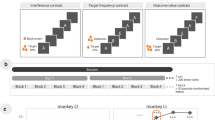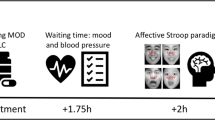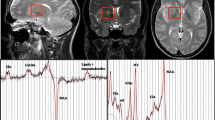Abstract
Goal-directed behavior requires the ability to resolve subliminally or consciously induced response conflicts, both of which may benefit from catecholamine-induced increases in gain control. We investigated the effects of presynaptic differences in dopamine and norepinephrine synthesis with the help of the tyrosine hydroxylase (TH) rs10770141 and the dopamine-β-hydroxylase (DBH) rs1611115, rs6271, and rs1611122 polymorphisms. Conscious and subliminal response conflicts were induced with flanker and prime distractors in (n = 207) healthy young participants while neurophysiological data (EEG) was recorded. The results demonstrated that the increased presynaptic catecholamine synthesis associated with the TH rs10770141 TT genotype improves cognitive control in case of consciously perceived (flanker) conflicts, but not in case of subliminally processed (prime) conflicts. Only norepinephrine seemed to also modulate subliminal conflict processing, as evidenced by better performance of the DBH rs1611122 CC genotype in case of high subliminal conflict load. Better performance was linked to larger conflict-induced modulations in post-response alpha band power arising from parietal and inferior frontal regions, which likely helps to suppress the processing of distracting information. In summary, presynaptic catecholamine synthesis benefits consciously perceived conflicts by improving the suppression of distracting information following a conflict. Subliminal conflicts were modulated via the same mechanism, but only by norepinephrine.





Similar content being viewed by others
References
Beste C, Mückschel M, Rosales R, Domingo A, Lee L, Ng A, Klein C, Münchau A (2017) The basal ganglia striosomes affect the modulation of conflicts by subliminal information-evidence from X-linked dystonia parkinsonism. Cereb Cortex N Y N 1991:1–10. https://doi.org/10.1093/cercor/bhx125
Eimer M, Schlaghecken F (2003) Response facilitation and inhibition in subliminal priming. Biol Psychol 64:7–26. https://doi.org/10.1016/S0301-0511(03)00100-5
Goschke T, Dreisbach G (2008) Conflict-triggered goal shielding: response conflicts attenuate background monitoring for prospective memory cues. Psychol Sci 19:25–32. https://doi.org/10.1111/j.1467-9280.2008.02042.x
Keye D, Wilhelm O, Oberauer K, Stürmer B (2013) Individual differences in response conflict adaptations. Front Psychol 4. https://doi.org/10.3389/fpsyg.2013.00947
McBride J, Boy F, Husain M, Sumner P (2012) Automatic motor activation in the executive control of action. Front Hum Neurosci 6. https://doi.org/10.3389/fnhum.2012.00082
Parkinson J, Haggard P (2014) Subliminal priming of intentional inhibition. Cognition 130:255–265. https://doi.org/10.1016/j.cognition.2013.11.005
Schlaghecken F, Eimer M (2004) Masked prime stimuli can bias “free” choices between response alternatives. Psychon Bull Rev 11:463–468. https://doi.org/10.3758/BF03196596
Stock A-K, Wolff N, Beste C (2017) Opposite effects of binge drinking on consciously vs. subliminally induced cognitive conflicts. NeuroImage 162:117–126. https://doi.org/10.1016/j.neuroimage.2017.08.066
Ulrich R, Schröter H, Leuthold H, Birngruber T (2015) Automatic and controlled stimulus processing in conflict tasks: superimposed diffusion processes and delta functions. Cogn Psychol 78:148–174. https://doi.org/10.1016/j.cogpsych.2015.02.005
Boy F, Husain M, Sumner P (2010) Unconscious inhibition separates two forms of cognitive control. Proc Natl Acad Sci 107:11134–11139. https://doi.org/10.1073/pnas.1001925107
Stock A-K, Friedrich J, Beste C (2016) Subliminally and consciously induced cognitive conflicts interact at several processing levels. Cortex J Devoted Study Nerv Syst Behav 85:75–89. https://doi.org/10.1016/j.cortex.2016.09.027
Li SC, Lindenberger U, Sikström S (2001) Aging cognition: from neuromodulation to representation. Trends Cogn Sci 5:479–486
Servan-Schreiber D, Printz H, Cohen JD (1990) A network model of catecholamine effects: gain, signal-to-noise ratio, and behavior. Science 249:892–895
Yousif N, Fu RZ, Abou-El-Ela Bourquin B et al (2016) Dopamine activation preserves visual motion perception despite noise interference of human V5/MT. J Neurosci 36:9303–9312. https://doi.org/10.1523/JNEUROSCI.4452-15.2016
Ziegler S, Pedersen ML, Mowinckel AM, Biele G (2016) Modelling ADHD: a review of ADHD theories through their predictions for computational models of decision-making and reinforcement learning. Neurosci Biobehav Rev 71:633–656. https://doi.org/10.1016/j.neubiorev.2016.09.002
Nieuwenhuis S, Aston-Jones G, Cohen JD (2005) Decision making, the P3, and the locus coeruleus--norepinephrine system. Psychol Bull 131:510–532. https://doi.org/10.1037/0033-2909.131.4.510
Aston-Jones G, Cohen JD (2005) An integrative theory of locus coeruleus-norepinephrine function: adaptive gain and optimal performance. Annu Rev Neurosci 28:403–450. https://doi.org/10.1146/annurev.neuro.28.061604.135709
Adelhöfer N, Gohil K, Passow S, Teufert B, Roessner V, Li SC, Beste C (2018) The system-neurophysiological basis for how methylphenidate modulates perceptual-attentional conflicts during auditory processing. Hum Brain Mapp 39:5050–5061. https://doi.org/10.1002/hbm.24344
Beste C, Adelhöfer N, Gohil K, Passow S, Roessner V, Li SC (2018) Dopamine modulates the efficiency of sensory evidence accumulation during perceptual decision making. Int J Neuropsychopharmacol 21:649–655. https://doi.org/10.1093/ijnp/pyy019
Chmielewski WX, Mückschel M, Ziemssen T, Beste C (2017) The norepinephrine system affects specific neurophysiological subprocesses in the modulation of inhibitory control by working memory demands. Hum Brain Mapp 38:68–81. https://doi.org/10.1002/hbm.23344
Mückschel M, Gohil K, Ziemssen T, Beste C (2017) The norepinephrine system and its relevance for multi-component behavior. NeuroImage 146:1062–1070. https://doi.org/10.1016/j.neuroimage.2016.10.007
Priebe NJ, Ferster D (2002) A new mechanism for neuronal gain control (or how the gain in brains has mainly been explained). Neuron 35:602–604. https://doi.org/10.1016/S0896-6273(02)00829-2
Mitchell SJ, Silver RA (2003) Shunting inhibition modulates neuronal gain during synaptic excitation. Neuron 38:433–445
Papasavvas CA, Wang Y, Trevelyan AJ, Kaiser M (2015) Gain control through divisive inhibition prevents abrupt transition to chaos in a neural mass model. Phys Rev E 92. https://doi.org/10.1103/PhysRevE.92.032723
Klein P-A, Petitjean C, Olivier E, Duque J (2014) Top-down suppression of incompatible motor activations during response selection under conflict. NeuroImage 86:138–149. https://doi.org/10.1016/j.neuroimage.2013.08.005
Ocklenburg S, Güntürkün O, Beste C (2011) Lateralized neural mechanisms underlying the modulation of response inhibition processes. NeuroImage 55:1771–1778. https://doi.org/10.1016/j.neuroimage.2011.01.035
Stürmer B, Siggelkow S, Dengler R, Leuthold H (2000) Response priming in the Simon paradigm. A transcranial magnetic stimulation study. Exp Brain Res 135:353–359
Verleger R, Kuniecki M, Möller F, Fritzmannova M, Siebner HR (2009) On how the motor cortices resolve an inter-hemispheric response conflict: an event-related EEG potential-guided TMS study of the flankers task. Eur J Neurosci 30:318–326. https://doi.org/10.1111/j.1460-9568.2009.06817.x
Leblois A (2006) Competition between feedback loops underlies normal and pathological dynamics in the basal ganglia. J Neurosci 26:3567–3583. https://doi.org/10.1523/JNEUROSCI.5050-05.2006
Mückschel M, Chmielewski W, Ziemssen T, Beste C (2017) The norepinephrine system shows information-content specific properties during cognitive control – evidence from EEG and pupillary responses. NeuroImage 149:44–52. https://doi.org/10.1016/j.neuroimage.2017.01.036
Bensmann W, Roessner V, Stock A-K, Beste C (2018) Catecholaminergic modulation of conflict control depends on the source of conflicts. Int J Neuropsychopharmacol 21:901–909. https://doi.org/10.1093/ijnp/pyy063
Elshoff J-P, Braun M, Andreas J-O, Middle M, Cawello W (2012) Steady-state plasma concentration profile of transdermal rotigotine: an integrated analysis of three, open-label, randomized, phase I multiple dose studies. Clin Ther 34:966–978. https://doi.org/10.1016/j.clinthera.2012.02.008
Schirinzi T, Pisani V, Imbriani P, di Lazzaro G, Scalise S, Pisani A (2018) Long-term treatment with rotigotine in drug-naïve PSP patients. Acta Neurol Belg 119:113–116. https://doi.org/10.1007/s13760-018-0993-x
Skirrow C, McLoughlin G, Banaschewski T, Brandeis D, Kuntsi J, Asherson P (2015) Normalisation of frontal theta activity following methylphenidate treatment in adult attention-deficit/hyperactivity disorder. Eur Neuropsychopharmacol 25:85–94. https://doi.org/10.1016/j.euroneuro.2014.09.015
Volkow ND, Wang GJ, Fowler JS, Gatley SJ, Logan J, Ding YS, Dewey SL, Hitzemann R et al (1999) Blockade of striatal dopamine transporters by intravenous methylphenidate is not sufficient to induce self-reports of “high”. J Pharmacol Exp Ther 288:14–20
Iversen LL, Iversen SD, Bloom FE, Roth RH (2009) Introduction to neuropsychopharmacology. Oxford University Press, New York
Prandovszky E, Gaskell E, Martin H, Dubey JP, Webster JP, McConkey GA (2011) The neurotropic parasite Toxoplasma gondii increases dopamine metabolism. PLoS One 6:e23866. https://doi.org/10.1371/journal.pone.0023866
Kobayashi K, Nagatsu T (2005) Molecular genetics of tyrosine 3-monooxygenase and inherited diseases. Biochem Biophys Res Commun 338:267–270. https://doi.org/10.1016/j.bbrc.2005.07.186
Nagatsu T, Levitt M, Udenfriend S (1964) Tyrosine hydroxylase. The initial step in norepinephrine biosynthesis. J Biol Chem 239:2910–2917
Barrie ES, Weinshenker D, Verma A, Pendergrass SA, Lange LA, Ritchie MD, Wilson JG, Kuivaniemi H et al (2014) Regulatory polymorphisms in human DBH affect peripheral gene expression and sympathetic activity. Circ Res 115:1017–1025. https://doi.org/10.1161/CIRCRESAHA.116.304398
Rao F, Zhang L, Wessel J, Zhang K, Wen G, Kennedy BP, Rana BK, Das M et al (2007) Tyrosine hydroxylase, the rate-limiting enzyme in catecholamine biosynthesis: discovery of common human genetic variants governing transcription, autonomic activity, and blood pressure in vivo. Circulation 116:993–1006. https://doi.org/10.1161/CIRCULATIONAHA.106.682302
Combarros O, Warden DR, Hammond N, Cortina-Borja M, Belbin O, Lehmann MG, Wilcock GK, Brown K et al (2010) The dopamine β-hydroxylase -1021C/T polymorphism is associated with the risk of Alzheimer’s disease in the Epistasis Project. BMC Med Genet 11. https://doi.org/10.1186/1471-2350-11-162
Cubells JF, Sun X, Li W, Bonsall RW, McGrath JA, Avramopoulos D, Lasseter VK, Wolyniec PS et al (2011) Linkage analysis of plasma dopamine β-hydroxylase activity in families of patients with schizophrenia. Hum Genet 130:635–643. https://doi.org/10.1007/s00439-011-0989-6
Cavanagh JF, Zambrano-Vazquez L, Allen JJB (2012) Theta lingua franca: a common mid-frontal substrate for action monitoring processes. Psychophysiology 49:220–238. https://doi.org/10.1111/j.1469-8986.2011.01293.x
Cavanagh JF, Frank MJ (2014) Frontal theta as a mechanism for cognitive control. Trends Cogn Sci 18:414–421. https://doi.org/10.1016/j.tics.2014.04.012
Chmielewski WX, Mückschel M, Dippel G, Beste C (2016) Concurrent information affects response inhibition processes via the modulation of theta oscillations in cognitive control networks. Brain Struct Funct 221:3949–3961. https://doi.org/10.1007/s00429-015-1137-1
Cohen MX (2014) A neural microcircuit for cognitive conflict detection and signaling. Trends Neurosci 37:480–490. https://doi.org/10.1016/j.tins.2014.06.004
De Blasio FM, Barry RJ (2013) Prestimulus delta and theta determinants of ERP responses in the Go/NoGo task. Int J Psychophysiol Off J Int Organ Psychophysiol 87:279–288. https://doi.org/10.1016/j.ijpsycho.2012.09.016
Harper J, Malone SM, Bernat EM (2014) Theta and delta band activity explain N2 and P3 ERP component activity in a go/no-go task. Clin Neurophysiol Off J Int Fed Clin Neurophysiol 125:124–132. https://doi.org/10.1016/j.clinph.2013.06.025
Mückschel M, Stock A-K, Dippel G, Chmielewski W, Beste C (2016) Interacting sources of interference during sensorimotor integration processes. NeuroImage 125:342–349. https://doi.org/10.1016/j.neuroimage.2015.09.075
Cohen MX, Donner TH (2013) Midfrontal conflict-related theta-band power reflects neural oscillations that predict behavior. J Neurophysiol 110:2752–2763. https://doi.org/10.1152/jn.00479.2013
Klimesch W (2012) α-Band oscillations, attention, and controlled access to stored information. Trends Cogn Sci 16:606–617. https://doi.org/10.1016/j.tics.2012.10.007
Klimesch W (2011) Evoked alpha and early access to the knowledge system: the P1 inhibition timing hypothesis. Brain Res 1408:52–71. https://doi.org/10.1016/j.brainres.2011.06.003
Klimesch W, Sauseng P, Hanslmayr S (2007) EEG alpha oscillations: the inhibition-timing hypothesis. Brain Res Rev 53:63–88. https://doi.org/10.1016/j.brainresrev.2006.06.003
Cohen MX, Ridderinkhof KR (2013) EEG source reconstruction reveals frontal-parietal dynamics of spatial conflict processing. PLoS One 8:e57293. https://doi.org/10.1371/journal.pone.0057293
Bauer M, Oostenveld R, Peeters M, Fries P (2006) Tactile spatial attention enhances gamma-band activity in somatosensory cortex and reduces low-frequency activity in parieto-occipital areas. J Neurosci 26:490–501. https://doi.org/10.1523/JNEUROSCI.5228-04.2006
Hoogenboom N, Schoffelen J-M, Oostenveld R, Parkes LM, Fries P (2006) Localizing human visual gamma-band activity in frequency, time and space. NeuroImage 29:764–773. https://doi.org/10.1016/j.neuroimage.2005.08.043
Schneider TR, Debener S, Oostenveld R, Engel AK (2008) Enhanced EEG gamma-band activity reflects multisensory semantic matching in visual-to-auditory object priming. NeuroImage 42:1244–1254. https://doi.org/10.1016/j.neuroimage.2008.05.033
Botvinick MM, Cohen JD, Carter CS (2004) Conflict monitoring and anterior cingulate cortex: an update. Trends Cogn Sci 8:539–546. https://doi.org/10.1016/j.tics.2004.10.003
Bari A, Robbins TW (2013) Inhibition and impulsivity: behavioral and neural basis of response control. Prog Neurobiol 108:44–79. https://doi.org/10.1016/j.pneurobio.2013.06.005
Aron AR, Robbins TW, Poldrack RA (2014) Inhibition and the right inferior frontal cortex: one decade on. Trends Cogn Sci 18:177–185. https://doi.org/10.1016/j.tics.2013.12.003
Allen C, Singh KD, Verbruggen F, Chambers CD (2018) Evidence for parallel activation of the pre-supplementary motor area and inferior frontal cortex during response inhibition: a combined MEG and TMS study. R Soc Open Sci 5:171369. https://doi.org/10.1098/rsos.171369
Horiguchi M, Ohi K, Hashimoto R, Hao Q, Yasuda Y, Yamamori H, Fujimoto M, Umeda-Yano S et al (2014) Functional polymorphism (C-824T) of the tyrosine hydroxylase gene affects IQ in schizophrenia: TH SNP affects IQ in schizophrenia. Psychiatry Clin Neurosci 68:456–462. https://doi.org/10.1111/pcn.12157
Sadahiro R, Suzuki A, Shibuya N, Kamata M, Matsumoto Y, Goto K, Otani K (2010) Association study between a functional polymorphism of tyrosine hydroxylase gene promoter and personality traits in healthy subjects. Behav Brain Res 208:209–212. https://doi.org/10.1016/j.bbr.2009.11.035
Nunez PL, Pilgreen KL (1991) The spline-Laplacian in clinical neurophysiology: a method to improve EEG spatial resolution. J Clin Neurophysiol Off Publ Am Electroencephalogr Soc 8:397–413
Perrin F, Pernier J, Bertrand O, Echallier JF (1989) Spherical splines for scalp potential and current density mapping. Electroencephalogr Clin Neurophysiol 72:184–187
Tallon-Baudry C, Bertrand O, Delpuech C, Permier J (1997) Oscillatory gamma-band (30-70 Hz) activity induced by a visual search task in humans. J Neurosci 17:722–734
Cooper PS, Darriba Á, Karayanidis F, Barceló F (2016) Contextually sensitive power changes across multiple frequency bands underpin cognitive control. NeuroImage 132:499–511. https://doi.org/10.1016/j.neuroimage.2016.03.010
Gross J, Kujala J, Hamalainen M, Timmermann L, Schnitzler A, Salmelin R (2001) Dynamic imaging of coherent sources: Studying neural interactions in the human brain. Proc Natl Acad Sci 98:694–699. https://doi.org/10.1073/pnas.98.2.694
Oostenveld R, Fries P, Maris E, Schoffelen J-M (2011) FieldTrip: Open source software for advanced analysis of MEG, EEG, and invasive electrophysiological data. Comput Intell Neurosci 2011:156869. https://doi.org/10.1155/2011/156869
Evans AC, Collins DL, Milner B, Milner B (1992) An MRI-based stereotactic atlas from 250 young normal subjects
Doppelmayr M, Klimesch W, Hödlmoser K, Sauseng P, Gruber W (2005) Intelligence related upper alpha desynchronization in a semantic memory task. Brain Res Bull 66:171–177. https://doi.org/10.1016/j.brainresbull.2005.04.007
Sauseng P, Klimesch W, Gruber W, Doppelmayr M, Stadler W, Schabus M (2002) The interplay between theta and alpha oscillations in the human electroencephalogram reflects the transfer of information between memory systems. Neurosci Lett 324:121–124
Bonnefond M, Jensen O (2013) The role of gamma and alpha oscillations for blocking out distraction. Commun Integr Biol 6:e22702. https://doi.org/10.4161/cib.22702
Wolff N, Zink N, Stock A-K, Beste C (2017) On the relevance of the alpha frequency oscillation’s small-world network architecture for cognitive flexibility. Sci Rep 7:13910. https://doi.org/10.1038/s41598-017-14490-x
Wolff N, Giller F, Buse J, Roessner V, Beste C (2018) When repetitive mental sets increase cognitive flexibility in adolescent obsessive-compulsive disorder. J Child Psychol Psychiatry 59:1024–1032. https://doi.org/10.1111/jcpp.12901
Kiefer M (2008) Top-down modulation of unconscious “automatic” processes: a gating framework. Adv Cogn Psychol 3:289–306. https://doi.org/10.2478/v10053-008-0032-2
Kiefer M, Ansorge U, Haynes J-D, Hamker F, Mattler U, Verleger R, Niedeggen M (2011) Neuro-cognitive mechanisms of conscious and unconscious visual perception: from a plethora of phenomena to general principles. Adv Cogn Psychol 7:55–67. https://doi.org/10.2478/v10053-008-0090-4
Muhle-Karbe PS, Duncan J, De Baene W et al (2017) Neural coding for instruction-based task sets in human frontoparietal and visual cortex. Cereb Cortex N Y N 1991 27:1891–1905. https://doi.org/10.1093/cercor/bhw032
Popov T, Westner BU, Silton RL, Sass SM, Spielberg JM, Rockstroh B, Heller W, Miller GA (2018) Time course of brain network reconfiguration supporting inhibitory control. J Neurosci 38:4348–4356. https://doi.org/10.1523/JNEUROSCI.2639-17.2018
Spielberg JM, Miller GA, Heller W, Banich MT (2015) Flexible brain network reconfiguration supporting inhibitory control. Proc Natl Acad Sci 112:10020–10025. https://doi.org/10.1073/pnas.1500048112
Funding
This study was funded by a grant from the Deutsche Forschungsgemeinschaft (DFG) SFB940 B8 to AS and CB.
Author information
Authors and Affiliations
Corresponding author
Ethics declarations
Conflict of Interests
The authors declare that they have no conflict of interest.
Ethical Approval
All procedures performed in studies involving human participants were in accordance with the ethical standards of the institutional and/or national research committee and with the 1964 Helsinki declaration and its later amendments or comparable ethical standards.
Informed Consent
Informed consent was obtained from all individual participants included in the study.
Additional information
Publisher’s Note
Springer Nature remains neutral with regard to jurisdictional claims in published maps and institutional affiliations.
Rights and permissions
About this article
Cite this article
Bensmann, W., Zink, N., Arning, L. et al. The Presynaptic Regulation of Dopamine and Norepinephrine Synthesis Has Dissociable Effects on Different Kinds of Cognitive Conflicts. Mol Neurobiol 56, 8087–8100 (2019). https://doi.org/10.1007/s12035-019-01664-z
Received:
Accepted:
Published:
Issue Date:
DOI: https://doi.org/10.1007/s12035-019-01664-z




